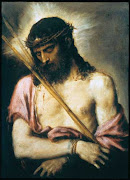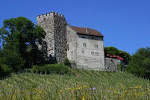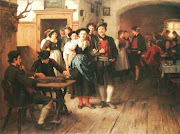This year, 2009, it virtually coincides with the Ember Days of September.
Ember Days are days of fasting and occur 4 times a year at Advent, Lent, Pentecost and the Exaltation of the Cross.
Even Dom Prosper Gueranger, the great liturgist of the Roman rite, speaks of them only in general terms as being days of fasting.
But they have a deeper significance still.
They are all liturgical days of ancient antiquity that remain from the days of the Jewish Temple worship.
The great Jewish feasts are continued in Leviticus 23.
Pesach or Passover, being the feast that our Lord transformed into the Mass on Maundy Thursday, of course, corresponds with our Easter Triduum. This feast also coincides with the Feast of Unleavened Bread, which lasts a week, and the Feast of the First Fruits.
Sha vu ot which is the Feast of Weeks or Pentecost, obviously corresponds to our Pentecost.
Sukkot which comprises the Feast of Trumpets (also Rosh Hashanah or Jewish New Year), the Day of Atonement, Yom Kippur, and the Feast of Tabernacles or Ingathering. This corresponds (usually) with the month of September in which often occurs the Jewish seventh month, that is Tishrei, and often coincides with the Ember Days of September.
New Year is the 1st day of Tishrei, Yom Kippur is the 10th day of Tishrei and the Feast of Tabernacles starts on the 15th day of Tishrei, when the fruits of the land are gathered in, and lasts 7 days beginning and ending with a Sabbath.
During those 7 days the Jews are required by the Law to live in tabernacles, or elaborate tents, so that "your posterity may know that I made the children of Israel to dwell in tabernacles, when I brought them out of the land of Egypt".
Of course, this is where we get our word "tabernacle" referring to the place wherein is kept the Blessed Sacrament over the High Altar in every Catholic Church.
The Jews believe (or are meant to believe) that the tabernacles also symbolised the dwellings of heaven. Thus the word "tabernacle" is all the more appropriate for use by the Church as the dwelling place of the Sacred Body and Blood of Christ, wherein the Lord of Heaven dwells here on the earth.
Here is a classic example of how the Ember Days retain crucial parts of the old Jewish Temple worship including the most sacred day of the year for Jews, Yom Kippur, the day of atonement.
The readings for the Ember Days are numerous but very fine because they retain those readings that relate to the old Jewish traditions and show the continuity with the Old Testament, show how our Lord fulfilled the Law and show how important it is to retain our ancient traditions in the Catholic Church.
It shows the hermeneutic of continuity from the time of Moses and Abraham to our Lord and on to our own day.
Where are the Ember Days in the new rite of Mass?
They probably remain as an option of some sort but let us face the truth with honesty and sincerity.
In the new rite the Ember Days simply are as good as never celebrated.
And yet the champions of the new rite assure us that the new rite has more of Scripture and the Old Testament in it!
Here are parts of the readings from Leviticus 23 which form the first 2 readings of Ember Saturday, yesterday:
"27 Upon the tenth day of this seventh month shall be the day of atonement, it shall be most solemn, and shall be called holy: and you shall afflict your souls on that day, and shall offer a holocaust to the Lord. 28 You shall do no servile work in the time of this day: because it is a day of propitiation, that the Lord your God may be merciful unto you. 29 Every soul that is not afflicted on this day, shall perish from among his people: 30 And every soul that shall do any work, the same will I destroy from among his people. 31 You shall do no work therefore on that day: it shall be an everlasting ordinance unto you in all your generations, and dwellings. 32 It is a sabbath of rest, and you shall afflict your souls beginning on the ninth day of the month: from evening until evening you shall celebrate your sabbaths".
[Lev. 23:27-32]
"39 So from the fifteenth day of the seventh month, when you shall have gathered in all the fruits of your land, you shall celebrate the feast of the Lord seven days: on the first day and the eighth shall be a sabbath, that is a day of rest. 40 And you shall take to you on the first day the fruits of the fairest tree, and branches of palm trees, and boughs of thick trees, and willows of the brook, and you shall rejoice before the Lord your God. 41 And you shall keep the solemnity thereof seven days in the year. It shall be an everlasting ordinance in your generations. In the seventh month shall you celebrate this feast. 42 And you shall dwell in bowers seven days: every one that is of the race of Israel, shall dwell in tabernacles: 43 That your posterity may know, that I made the children of Israel to dwell in tabernacles, when I brought them out of the land of Egypt. I am the Lord your God".
[Lev. 23:39-43]
...







.jpg)

















_-002.jpg/220px-Circle_of_Anton_Raphael_Mengs,_Henry_Benedict_Maria_Clement_Stuart,_Cardinal_York_(ca_1750)_-002.jpg)


6 comments:
The Ember Wednesday Lesson from the Second History of Esdras always makes me cry. The people have after long exile reached Jerusalem and are at last gathered together before the water gate and Esdras brings out the Book of Moses to read the Law to the Assembly.
"And he read it plainly in the street that was before the water gate, from the morning until midday before the men and women, and all those that could understand; and the ears of all the people were attentive to the book. And Esdras the scribe stood upon a step of wood, which he made to speak upon. And he opened the book before all the people, for he was above all the people; and when he had opened it, all the people stood. And Esdras blessed the Lord the Great God, and all the people answered,
Amen! Amen!
lifting up their hands; and they bowed down, and adored God, with their faces to the ground."
Marvellous!! Thank you for that.
The Sacred Texts of Ember Saturdays in Lent and Pentecost can be found here...
http://web.me.com/thomaswindsor/Society_of_St._Bede/Temporal_Cycle.html
Tom
Thanks, Tom!
Thank you for an enlightening post. I have just discovered your blog and I am enjoying learning more of the deep tradition of our Catholic faith.
The Ember days were uniquely Roman.
They were removed from the 1969 calendar and it was left up to individual bishops conferences to establish other appropriate seasonal feasts. Few if any did so.
[Concerning the picture of the Benedictine Abbey of St Marie Madeleine at Le Barroux, why are they wearing white if they are celebrating the Ember Days? They should be in violet, except during the Pentecost Octave Ember days when in red.]
Finally, I believe the novus ordo mentality does not like the Ember Days because while they can be associated with Jewish feasts, the Ember Days also make it clear that the Old Law has come to fulfillment in the New. This is not "kosher" in the age of interfaith dialogue. Thus, the Old Law ceremonies, though once good and holy as acts of faith in the Messiah before His advent, are now in themselves objectively acts of perfidy declaring that He has not come. (q.v. Aquinas S.T. I-II.95-105)
Post a Comment